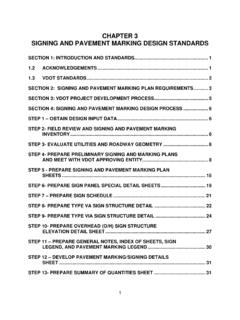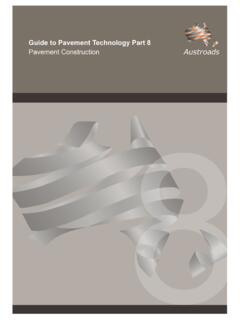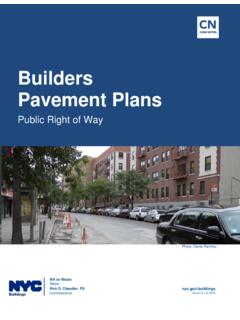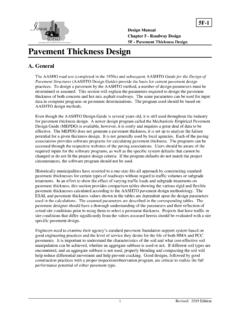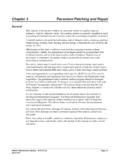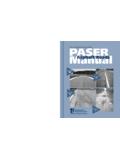Transcription of Design Guidelines - Pavement Design
1 PINE RIVERS SHIRE COUNCIL PLANNING SCHEME POLICY 28 CIVIL INFRASTRUCTURE Design Design Guidelines DG 01 Roundabouts DG 02 Engineering Drawings DG 03 As Constructed Information DG 04 Local Area Traffic Management DG 05 Pavement Design DG 06 Recreational Trails Planning, Construction and Maintenance DG T10 Landscape Construction on Road Reserves, Parks and Drainage Reserves DG T11 On-Site Carparking and Service Vehicle Facilities PINE RIVERS SHIRE COUNCIL Design Guidelines DG 05 Pavement Design Pine Rivers Shire Council Design Manual Design Guidelines - DG 05 - Pavement Design March 2008 PINE RIVERS SHIRE COUNCIL DG 05 - Pavement Design DG 05 Pavement Design INTRODUCTION ..1 Purpose ..1 Reference Documents ..1 SUBGRADE EVALUATION ..2 General ..2 Field Testing and Sampling.
2 2 Laboratory Testing ..3 Subgrade CBR at Equilibrium Moisture Design CBR DETERMINATIONS FOR DELINEATED MINOR STREET Pavement Design ..6 General ..6 Traffic Flexible Pavement Rigid Pavement MAJOR ROAD Pavement Design ..10 General ..10 Traffic Flexible Pavement Alternative Pavement Designs ..14 SUBSURFACE SUBGRADE INSPECTIONS ..15 APPENDIX Subgrade Evaluation Report Sheets ..16 FIGURES 1, 2 and 3 ..16 APPENDIX Flexible Pavement Design Charts ..20 Figures 4, 5 and 6 ..20 APPENDIX Estimation of Laboratory APPENDIX Summary of Unbound Pavement 1 Pine Rivers Shire Council Design Manual Design Guidelines - DG 05 - Pavement Design March 2008 INTRODUCTION PURPOSE To outline the minimum requirements for subgrade evaluation and structural Design of street and road pavements within Pine Rivers Shire.
3 To accumulate a database of test results which will lead to a more efficient determination of subgrade material properties. SCOPE This guideline sets out recommended procedures for:- (a) the sampling and testing of Pavement subgrade materials (b) adoption of Design CBR for Pavement subgrade materials (c) Design methods for determining flexible Pavement thickness (d) Design methods for rigid pavements ( reinforced concrete) REFERENCE DOCUMENTS This Guideline is based on the following reference documents:- (a) Australian Road Research Board (ARRB) Special Report No. 41 "Into A New Age of Pavement Design " which was prepared for and on behalf of Australian Local Government Authorities. ARRB Special Report No. 41, except as noted otherwise in this guideline, is to be adopted in the structural Design of minor urban and non-urban street and road pavements.
4 Reference should be made to the report for explanation of terms used in this guideline and for background information and examples of the method for determining Pavement thicknesses for minor streets and roads. (b) Queensland Department of Main Roads ( ) Design Manual, which is appropriate for the Design of major road pavements. The Pavement Design Manual, except as noted otherwise in this guideline, is to be adopted in the structural Design of major urban and non-urban road pavements. Reference should be made to the Pavement Design Manual for explanation of the terms used in this guideline and for background information and examples of determining traffic loadings and appropriate Pavement thickness for major roads. INTERPRETATION In the event of any discrepancies between this guideline and the reference documents a final determination shall be made by a Pine Rivers Shire Council engineer.
5 2 Pine Rivers Shire Council Design Manual Design Guidelines - DG 05 - Pavement Design March 2008 SUBGRADE EVALUATION GENERAL In designing a new Pavement , it is essential that the strength and stiffness of the supporting subgrade be logically assessed and that variations in properties of the subgrade be accurately predicted. The long term performance of the new Pavement will depend not so much on the strength of the subgrade achieved at construction, but more on the strength of the subgrade at equilibrium moisture conditions after Pavement construction. The Country Roads Board of Victoria formulated a method for estimating the laboratory CBR from soil classification tests (for fine grained soils). This method has been incorporated in this manual on a trial basis to determine if estimated laboratory CBRs based on soil classification tests can be related to laboratory soaked CBRs for subgrade soils encountered within the Pine Rivers Shire.
6 It is envisaged that a database of laboratory classification tests, estimated laboratory CBRs and soaked CBRs will eventually be produced, and this may lead to a reduction in the number of soaked CBRs required in evaluating subgrade materials. The soil classification tests required are Particle Size Distribution, Liquid Limit, Plastic Limit and Linear Shrinkage. FIELD TESTING AND SAMPLING Subgrade investigation should be carried out prior to completion of subgrade preparation along the alignment of new Pavement construction. The purpose of the field testing and sampling is to identify the extent and properties of the various subgrade materials likely to be encountered. Particular attention needs to be paid to the soils at anticipated subgrade level and those immediately underlying it.
7 The investigation should be based principally on a series of bores or test pits from which soil samples are obtained and (if relevant) in situ testing carried out. The frequency of test locations will vary depending on the following:- (a) topography of the Pavement route (b) variation in depths of excavation along the Pavement route (c) anticipated variation in subgrade materials The frequency of test locations for any specific site shall be to the satisfaction of a Pine Rivers Shire Council engineer. The minimum sampling frequencies are given in Table below: - Table Pavement LENGTH MINIMUM SAMPLING/TESTING FREQUENCY Less than 100m 1 per change in material (1 locations min) 100m to 200m 1 per change in material (2 locations min) 200m to 500m 1 per change in material (3 locations minimum) Greater than 500m 1 per change in material or 1 per 250m or part thereof (3 locations min) Sampling and testing frequencies for Pavement widening should be the same as for new Pavement construction.
8 Additional testing may be required where in the opinion of a Pine Rivers Shire Council engineer variation in situ material properties may exist. 3 Pine Rivers Shire Council Design Manual Design Guidelines - DG 05 - Pavement Design March 2008 Bores/test pits should be extended at least 500mm below the anticipated subgrade level and samples collected of strata penetrated. Sufficient bulk samples of representative subgrade materials should be collected to enable samples to be classified in the laboratory by field moisture, Atterberg limits, linear shrinkage and soaked CBR testing. Soils encountered in the bores/pits at depths other than at anticipated subgrade level and which are different to those at anticipated subgrade level should be visually classified and recorded, and samples taken for moisture content determinations or confirmatory classification testing, as required.
9 Static or dynamic cone penetration tests may also be carried out (or nominated by a Pine Rivers Shire Council engineers to be carried out) if the subgrade moisture conditions are considered to be representative of equilibrium moisture conditions. A Pine Rivers Shire Council engineer may relax the requirement for sampling/testing for subgrade assessment in areas of new Pavement where in excess of 500mm of filling is yet to be placed to achieve subgrade formation level. Sampling/testing should, however, be carried out on materials to be won from site which are to be used as filling in Pavement areas, as the properties of this filling will dictate the overlying Pavement thickness. An estimate of likely subgrade drainage conditions ( good, fair or poor) and observations whether springs are evident in the near vicinity of the test location should also be made.
10 This estimate is applicable to the determination of an appropriate 'F' factor (refer to Section ). Strata encountered at each test location should be recorded and presented in the format of the attached Test Bore / Test Pit Report sheet - refer Appendix A - Figure 1. LABORATORY TESTING Laboratory testing should be carried out on samples collected at anticipated subgrade level from each bore/test pit location to collect the results required in Table All tests should be carried out in a NATA registered laboratory and in accordance with relevant test methods detailed in AS1289 "Methods of Testing Soils for Engineering Purposes" (or its updated equivalent). Table TESTED RESULT PROVIDED AS Field moisture content % Sieve grading analysis % passing mm % passing 425 m % passing 75 m Liquid limit % Plastic limit % Plasticity index % Linear shrinkage % Laboratory soaked CBR % Laboratory soaked CBRs should be carried out on samples compacted to a dry density ratio of 100% standard compaction, at standard optimum moisture content and with the appropriate surcharge.








